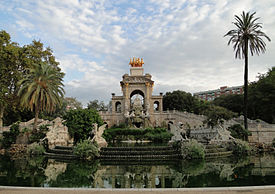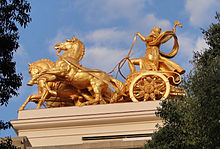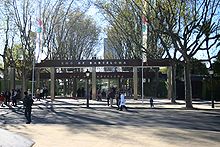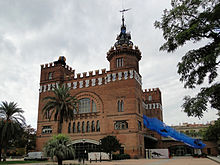- Parc de la Ciutadella
-
Parc de la Ciutadella 
The park's fountainType Historical garden Location Barcelona Created 1877 Status Open all year Website Parcs i jardins de Barcelona The Parc de la Ciutadella (Catalan pronunciation: [ˈparg də ɫə siwtəˈðeʎə], "Ciutadella Park") is a park in Ciutat Vella, Barcelona, Spain. After its establishment during the mid 19 century, it was for decades the only green area in the city, and hitherto of the most popular. It is located at the northeastern edge of the old town, and hosts within its 70 acres (280,000 m2) the city's substantial zoo (which was home to the famous albino gorilla Snowflake), the Parliament of Catalonia, a lake, some museums, and a fountain of considerable size designed by Josep Fontserè (with perhaps some attributions of the young student Antoni Gaudí, who at this time worked at Fontserès office). It is characterized by being a very busy place, crowded with tourists, and locals, who are usually going for a walk or taking their children to the special section for kids found near the upper margin of the park. This park is optimal for sports, like for example boating in the lake, cycling (both boat and bicycle can be hired), or jogging.
The main attraction has, from its establishment hitherto been the zoo. This was due to out of the 7,000 animals present the albino gorilla Snowflake, who has died in 2004. Near the zoo's entrance, the famous climbable gigantic stone mammoth is to be seen, just as the metallic cat in another perimeter of the park.
Another yet to be mentioned conspicuous characteristic is the park's paths' layout, one half being made up by sinuous and rather natural seeming trails, and the other by direct and refined ones. Along both, huge a variety of vegetation is assertively displayed, having small signposts at their front, serving as name tags.Contents
Locations
The Citadel
In 1714, after a 13 month war (War of the Spanish Succession), Barcelona fell to the army of Philip V of Spain. In order to maintain stark control over the city, and to hold the Catalan citizens from rebelling like they did in the last century, King Philips V built the citadel of Barcelona, the at that time largest fortress of whole Europe, using the park of French Luxembourg as an exemplification.
A substantial part of the district it was constructed in (La Ribera) was destroyed to obtain the necessary space, leaving its inhabitants audaciously and carelessly homeless. The fortress was characterized by having five corners, which proffered the citadel defensive power, and by a rather wide surrounding margin, serving as location for the army's myriad of cannons. It included all the necessary buildings to house 8,000 people.
Hundreds of Catalonians were forced to pertinaciously work on the erection for three years, while the rest of the city provided financial backing not only for the construction, but for warfare related expenses as well, with a newly effectuated tax named El Cadestre. Three decades later a quarter was rebuilt around the fortress and until today named Barceloneta, which is located inside the neighborhood Ciutat Vella.
In 1841 the city's authorities decided to destroy the fortress, for it was abhorred by Barcelona's citizens. Yet, two years later, in 1843, under regime of Maria Cristina, the citadel was restored. In 1848, after Maria Cristinas's abdication and as the citadel lost its use, General Espartero razed most of the buildings within the fortress with its walls to the ground by bombarding it from a nearby mountain named Montjuic, which helped him beget political popularity. By 1869, as the political climate liberalised enough to permit it, General Prim decided to turn over what was left of the fortress to the city and demolishment of some buildings thus eventuated under Catalan orders, for it was viewed as by the citizens as a much-hated symbol of central Spanish government.
The chapel (now the Military Parish Church of Barcelona), the Governor's palace (now Verdaguer Secondary School) and the arsenal (which is now home to the Catalan Parliament) endured to date, with the rest of the site being turned into the park of the citadel as we now know it, on the quondam grounds of the actual fortress, as work by the architect Josep Fontsére in 1872. 19 years later, in 1888, Barcelona held the Exposición Universal de Barcelona extravaganza, inspired by Mayor Rius i Taulet, and the park was redesigned by addition of sculptures and other complemental works of art. The aforementioned eventuation marked the conclusion of the old provincial and unprogressive Barcelona and the establishment of a modern cosmopolitan city. From that point until 1892, half of the park's layout was yet again enhanced, in order to obtain sufficient space for the zoo.
The Cascada
The Cascada (waterfall or cascade in Spanish) is located at the northern corner of the park opposite to the lake. It was first inaugurated in 1881 without sculptures or any meticulous details, and was thereby criticized by the press, after which this triumphal arch was thoroughly amended by the addition of a fountain and some minor attributes, which required six years of construction from 1882 to 1888, and was thenceforth put on display at the Universal Exhibition, and hitherto not been redesigned. It was erected by Josep Fontsére and to a small extent by Antoni Gaudí, who at that time was still an unknown student of architecture. Fontsére aimed to loosely make it bear resemblance to the Trevi Fountain of Rome.
Two enormous pincers of gigantic crabs serve as stairs to access a small podium located in the centre of the monument. In front of it a sculpture (designed by Venanci Vallmitjana) of Venus standing on an open clam was placed. The whole cascade is divided in two levels. From the podium on a path leads to the Feminine Sculpture and to the northeastern corner of the park, and upon following the route down the stairs the fountain's pond is rounded and the southern tip of the artifact is reached.The Lake
The lake characterizes the park as a scenery enjoyable for romantics. The lake's location, surroundings, and visitors turns this big sector into a rather convivial place, in which little turtles can be found on rocks, and fishes dashing through the water. Just next to it lies the thickest and most beauteous vegetation that can be spotted in the green areas of Barcelona. There is a locally somewhat famous tree which grows inside the water and separates from the other due to its attractive form and its propagation of bananas.
The zoo
The zoo of Barcelona is located in the park of the ciutadella due to the availability of a few buildings which were left empty after the Universal Exposition of 1888. It was inaugurated in 1892, during the day of the Mercé, the patron saint of the city. The first animals were donated by Lluís Martí i Codolar to the municipality of Barcelona, which gratefully approved of the their accommodation in the zoo.
Nowadays, with one of the most substantial collections of animals in Europe, the zoo affirms that their aim is to conserve, investigate, and educate.
From 1966 to 2003 the zoo was home to the famous albino gorilla Snowflake, who attracted many international tourists and locals.
Apart from the usual visits, different types of guided tours or other activities are offered, like for example 20 types of diversionary workshops, excursions and fieldtrips for schoolchildren, or personnel training and educational courses in zoology for adults. More than 50,000 children visit the zoo on an annual basis, which is the reason for the zoo's emphasis on education.
Its opening times are:- January/February/March 1–15: 10:00 to 17:30
- March 16–31/April/May: 10:00 to 19:00
- June/July/August/September: 10:00 to 20:00
- October 1–14: 10:00 to 19:00
- October 25–31/November/December: 10:00 to 17:30
Museums
Museum of zoology
The zoology museum of Barcelona, together with the museum of geology, make up the Museum of Natural Science. It was constructed briefly previous to the Exposición Universal de Barcelona (1888) by the architect Lluís Doménech i Montaner, and served as exhibition to the aforementioned extravaganza. Most of the building is constructed, as to be seen on the right picture, with red bricks. The most popular displays are the gigantic skeleton of the whale, and the exhibits dedicated for smaller children. The institute's authorities aver that their vital aims are to enhance knowledge and conservation of the natural diversity of Catalonia and its surroundings, and to promote the public the learning and discovery of the natural world, just as to transmit ethical values of respect for nature and to stimulate informed debate on the burning issues and environmental problems that concern society.
Permanent exhibitions:- Mineralogy, petrology and paleontology
- The volcanic region of Olot
- The mineral's secret colors
- The animal kingdom
- Urban birds
- The apiary
Timetable:
- Tuesday through Saturday: 10:00 to 18:00
- Sunday: 10:00 to 14:300
- Mondays closed
Museum of geology
The museum of geology is a legacy of the scientist Francisco Martorell i Peña (1822–1878). He donated his whole collection of artifacts of cultural and archeological importance, his scientific library, and an amount of 125.00 pesetas to the city, and demanded correct usage of these by means of the founding of a new museum to save his bequest. That same year a new building was constructed for the requested purpose, and named by the Corporación Municipal after its donor. The responsible architect was Antoni Rivas i Trias, who decided to build the museum in the park of the citadel.
Transport
The Barcelona Metro and Trambesòs station Ciutadella-Vila Olímpica, on L4, is named after the park and the nearby area Vila Olímpica. The entrance to the park, however, is closer to the metro and Rodalies Barcelona (commuter train network) station Arc de Triomf. The city's central bus station Estació del Nord is also close.
References
- http://www.bcn.es/turisme/english/turisme/llocs/04.htm
- http://www.aviewoncities.com/barcelona/parcdelaciutadella.htm
- http://www.bcn.es/turisme/english/turisme/rutes/jardins_int_fr.htm
- http://www.ub.es/geocrit/ciutadella.htm
- http://www.gothereguide.com/parc+de+la+ciutadella+barcelona-place/
- http://sobrehistoria.com/el-parque-de-la-ciudadela-en-barcelona-un-or
- http://www.viajejet.com/parque-de-la-citadella-barcelona/
- http://www.museuzoologia.bcn.es
External links
- http://www.aviewoncities.com/barcelona.htm
- http://www.bcn.es/turisme/english/turisme/
- http://maps.google.com/maps?f=q&source=s_q&abauth=1d71f2c4%3Axb3r8M0wKNb9nd4540IHCi-s6Ms&view=text&q=barcelona&btnG=Search+Maps
- http://w3.bcn.es/XMLServeis/XMLHomeLinkPl/0,4022,375670355_703434886_3,00.html
- http://www.museuzoologia.bcn.es
Barcelona landmarks Buildings and
interesting places:Arc de Triomf · Avinguda Diagonal · Barcelona Pavilion · Bellesguard · Biblioteca de Catalunya · Casa Amatller · Casa Batlló · Casa Calvet · Casa de l'Ardiaca · Casa Fuster · Casa Lleó-Morera · Casa Milà · Casa Terrades · Casa Vicens · Castell dels Tres Dragons · Cathedral of Santa Eulalia · Columbus Monument · Dona i Ocell · Drassanes Reials · Els Quatre Gats · Estació de França · Fabra Observatory · Font de Canaletes · Forum Building · Fossar de les Moreres · Fundació Joan Miró · Hospital de Sant Pau · Hospital de Sant Pau · Hotel Arts · Hotel Habitat Sky · IMAX Barcelona · Jewish quarter · Jonqueres Monastery · La Boqueria · L'Auditori · L'Illa · Magic Fountain of Montjuïc · Mercat del Born · Mercat de Sant Antoni · Montjuïc Castle · Montjuïc Communications Tower · Olympic Harbour · Olympic Ring of Barcelona · Palau del Baró de Quadras · Palau Episcopal de Barcelona · Palau Güell · Palau de la Generalitat de Catalunya · Palau Reial Major · Palau Robert · Palau de la Virreina · Parliament of Catalonia · Pedralbes Monastery · Poble Espanyol · Sagrada Família · Sagrat Cor · Sala de les Cent Columnes · Santa Maria del Mar · Santa Maria del Pi · Torre Agbar · Torre de Collserola · Vapor Vell · World Trade Center Barcelona
Streets and squares: Avinguda Diagonal · Carrer d'Avinyó · Carrer Ferran · Carrer Tallers · Gran Via de les Corts Catalanes · La Rambla · Passeig de Gràcia · Plaça de Catalunya · Plaça d'Espanya · Plaça Reial · Plaça Sant Jaume · Plaça de Sant Felip Neri · Rambla de CatalunyaMuseums: Archaeology Museum of Catalonia · Caixafòrum · CCCB · CosmoCaixa Barcelona · Fundació Antoni Tàpies · Gracia Arts Project · Institut Botànic de Barcelona · Jardí Botànic · MACBA · Museu de les Arts Decoratives · Museu Castell de Montjuïc & Museu Militar · Wax museum · Museu de Ceràmica · Museu de la Ciència · Egyptian Museum · Museu de l'Eròtica de Barcelona · Museu Etnològic · Museu Frederic Marès · Museu d'Història de Catalunya · Museu d'Història de la Ciutat · Maritime Museum · Museu del Modernisme Català · Museu de la Música · Museu Nacional d'Art de Catalunya · Museu del Perfum de Barcelona · Museu Picasso · Museu Tèxtil i d'Indumentària · Museu de la XocolataSports: Camp Municipal Narcís Sala · Camp Nou · Camp de Les Corts · Estadi de Sarrià · Estadi Olímpic Lluís Companys · Mini Estadi · Palau dels Esports · Palau Blaugrana · Palau Sant JordiPerforming arts: Gran Teatre del Liceu · L'Auditori · Palau de la Música Catalana · Teatre Apolo · Teatre Grec · Teatre Lliure · Teatre Poliorama · Teatre RomeaParks: Laberint d'Horta · Parc de les Aigües · Parc de la Ciutadella · Parc de Diagonal Mar · Parc de l'Espanya Industrial · Park Güell · Parc de la Creueta del Coll · Parc Joan Miró · MontjuïcZoos: Aquarium Barcelona · Parc Zoològic de BarcelonaBeaches: Barceloneta beach · Bogatell beach · Mar Bella beach · Nova Icària beach · Nova Mar Bella beach · Sant Sebastià beachCategories:- Parks in Barcelona
- Ciutat Vella (district of Barcelona)
Wikimedia Foundation. 2010.






